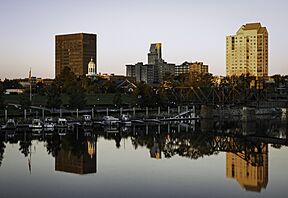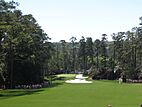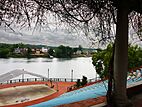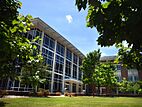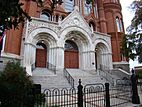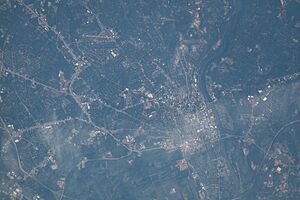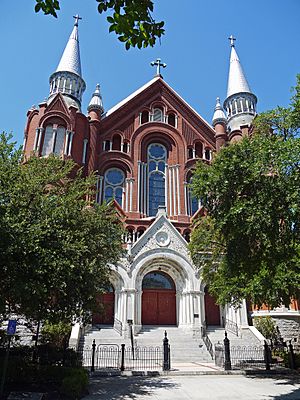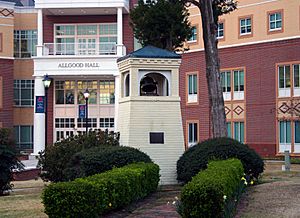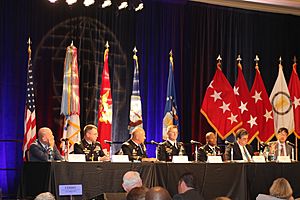Augusta, Georgia facts for kids
Quick facts for kids
Augusta
|
||
|---|---|---|
|
Augusta National Golf Club
Riverwalk Augusta on the Savannah River
The University Hall at Augusta University
Sacred Heart Cultural Center
Augusta Canal with Enterprise Mill in the background
Old Government House
|
||
|
||
| Nickname(s):
"The Garden City"
|
||
| Motto(s):
"We Feel Good"
|
||
| Country | ||
| State | ||
| County | Richmond | |
| Established | 1736 | |
| Consolidated | 1996 | |
| Founded by | James Oglethorpe | |
| Named for | Princess Augusta of Saxe-Gotha | |
| Area | ||
| • City | 306.44 sq mi (797.70 km2) | |
| • Land | 302.28 sq mi (782.90 km2) | |
| • Water | 4.17 sq mi (10.80 km2) | |
| Elevation | 136 ft (45 m) | |
| Population
(2020)
|
||
| • City | 202,081 | |
| • Rank | 116th in the United States 3rd in Georgia |
|
| • Density | 668.52/sq mi (258.12/km2) | |
| • Urban | 431,480 (US: 95th) | |
| • Urban density | 1,578.8/sq mi (609.6/km2) | |
| • Metro | 611,000 (US: 95th) | |
| Time zone | UTC−5 (EST) | |
| • Summer (DST) | UTC−4 (EDT) | |
| ZIP codes |
30901, 30904, 30906, 30907, 30909, 30912, 30815
|
|
| Area codes | 706, 762 | |
Augusta is a city located on the eastern border of Georgia, right across the Savannah River from North Augusta, South Carolina. It's the third-largest city in Georgia, after Atlanta and Columbus.
In 2020, Augusta had a population of over 202,000 people. This makes it one of the largest cities in the United States. In 1996, the city of Augusta and Richmond County joined together to form one government.
Augusta was founded in 1736. It was named after Princess Augusta of Saxe-Gotha, who was the mother of British King George III. The city is famous around the world for hosting the Masters golf tournament every spring. This event brings more than 200,000 visitors to the Augusta National Golf Club.
Augusta is about a two-hour drive from Atlanta. It is home to Fort Eisenhower, a big U.S. Army base. In 2016, it was announced that a new National Cyber Security Headquarters would be built in Augusta. This makes the city important for computer security.
Contents
History of Augusta
How Augusta Started
Long ago, Native American tribes lived along the Savannah River. They used this area as a good place to cross the river. This was because of its location on the fall line, where the land drops.

In 1735, James Oglethorpe, who founded Savannah, sent soldiers to explore the Savannah River. He told them to build a fort where the river became easy to travel by boat. The next year, a settlement was created to protect the coast from possible attacks. Oglethorpe named the town Augusta after Princess Augusta of Saxe-Gotha.
During the American Revolutionary War, Americans took the city back from the British in the Siege of Augusta. Augusta was also Georgia's second state capital from 1785 to 1795.
Augusta's Growth
Augusta grew quickly as a market town. The surrounding area became important for growing cotton. The invention of the cotton gin made it easier to process cotton. This led to many enslaved people being brought to the area to work on plantations.
During the American Civil War, Augusta had many factories that made things for the war. After the war, the city's textile industry grew. Many mills were built along the Augusta Canal, like Enterprise Mill and Sibley Mill.
In 1916, a large fire damaged 25 blocks of the city. Many historic buildings were affected.
Geography and Climate
Augusta is located right on the border between Georgia and South Carolina. It's about 150 miles (240 km) east of Atlanta.
The city covers about 306.5 square miles (794 km²). Most of this is land, with a small amount of water. Augusta is on the Savannah River at the fall line. This means there are small waterfalls on the river. It's also where the river stops being easy to travel by boat.

The Clarks Hill Dam is near Augusta, forming Clarks Hill Lake. Downstream, the Stevens Creek Dam creates hydroelectric power. Even further down is the Augusta Diversion Dam, which sends water from the Savannah River into the Augusta Canal.
What is Augusta's Weather Like?
Augusta has a humid subtropical climate. This means it has short, mild winters and very hot, humid summers. The average temperature in January is about 45°F (7°C), and in July it's about 81°F (27°C).
It gets very hot in summer, with temperatures often reaching 90°F (32°C) or higher. Snowfall is not very common in Augusta. The most snow ever recorded was 14 inches (36 cm) in February 1973.
| Climate data for Augusta Regional Airport, Georgia (1991–2020 normals, extremes 1871–present) | |||||||||||||
|---|---|---|---|---|---|---|---|---|---|---|---|---|---|
| Month | Jan | Feb | Mar | Apr | May | Jun | Jul | Aug | Sep | Oct | Nov | Dec | Year |
| Record high °F (°C) | 84 (29) |
88 (31) |
93 (34) |
96 (36) |
101 (38) |
106 (41) |
107 (42) |
108 (42) |
106 (41) |
101 (38) |
90 (32) |
84 (29) |
108 (42) |
| Mean maximum °F (°C) | 75.6 (24.2) |
78.8 (26.0) |
84.9 (29.4) |
88.7 (31.5) |
94.3 (34.6) |
98.1 (36.7) |
99.8 (37.7) |
99.1 (37.3) |
95.1 (35.1) |
89.0 (31.7) |
82.1 (27.8) |
76.9 (24.9) |
100.8 (38.2) |
| Mean daily maximum °F (°C) | 59.6 (15.3) |
63.5 (17.5) |
71.0 (21.7) |
78.5 (25.8) |
85.9 (29.9) |
91.3 (32.9) |
94.1 (34.5) |
92.6 (33.7) |
87.8 (31.0) |
79.0 (26.1) |
69.1 (20.6) |
61.5 (16.4) |
77.8 (25.4) |
| Daily mean °F (°C) | 47.4 (8.6) |
50.8 (10.4) |
57.5 (14.2) |
64.6 (18.1) |
72.7 (22.6) |
79.7 (26.5) |
82.8 (28.2) |
81.8 (27.7) |
76.4 (24.7) |
66.0 (18.9) |
55.6 (13.1) |
49.4 (9.7) |
65.4 (18.6) |
| Mean daily minimum °F (°C) | 35.3 (1.8) |
38.1 (3.4) |
44.1 (6.7) |
50.6 (10.3) |
59.6 (15.3) |
68.1 (20.1) |
71.6 (22.0) |
71.0 (21.7) |
65.0 (18.3) |
53.1 (11.7) |
42.2 (5.7) |
37.3 (2.9) |
53.0 (11.7) |
| Mean minimum °F (°C) | 17.9 (−7.8) |
21.0 (−6.1) |
25.8 (−3.4) |
33.7 (0.9) |
44.1 (6.7) |
56.5 (13.6) |
63.1 (17.3) |
61.5 (16.4) |
50.4 (10.2) |
35.1 (1.7) |
25.4 (−3.7) |
20.6 (−6.3) |
15.9 (−8.9) |
| Record low °F (°C) | −1 (−18) |
3 (−16) |
12 (−11) |
26 (−3) |
35 (2) |
46 (8) |
54 (12) |
52 (11) |
36 (2) |
22 (−6) |
11 (−12) |
5 (−15) |
−1 (−18) |
| Average precipitation inches (mm) | 3.84 (98) |
3.67 (93) |
4.08 (104) |
2.92 (74) |
3.05 (77) |
4.75 (121) |
4.48 (114) |
4.61 (117) |
3.60 (91) |
2.56 (65) |
2.66 (68) |
3.87 (98) |
44.09 (1,120) |
| Average snowfall inches (cm) | 0.4 (1.0) |
0.3 (0.76) |
0.0 (0.0) |
0.0 (0.0) |
0.0 (0.0) |
0.0 (0.0) |
0.0 (0.0) |
0.0 (0.0) |
0.0 (0.0) |
0.0 (0.0) |
0.0 (0.0) |
0.1 (0.25) |
0.8 (2.0) |
| Average precipitation days (≥ 0.01 in) | 9.9 | 9.1 | 8.6 | 7.6 | 7.9 | 11.1 | 11.3 | 11.1 | 7.9 | 6.4 | 7.0 | 9.4 | 107.3 |
| Average snowy days (≥ 0.1 in) | 0.3 | 0.1 | 0.0 | 0.0 | 0.0 | 0.0 | 0.0 | 0.0 | 0.0 | 0.0 | 0.0 | 0.1 | 0.5 |
| Average relative humidity (%) | 69.8 | 65.8 | 65.0 | 64.5 | 69.6 | 71.3 | 73.9 | 76.5 | 76.2 | 73.3 | 71.9 | 71.6 | 70.8 |
| Source: NOAA (relative humidity 1961–1990) | |||||||||||||
Historic Areas in Augusta
Augusta has 10 historic districts. The most famous is the Augusta Downtown Historic District. It covers most of downtown Augusta and its older parts. This district was added to the National Register of Historic Places in 2004.
Other historic districts in Augusta include:
- Bethlehem Historic District
- Broad Street Historic District
- Greene Street Historic District
- Harrisburg–West End Historic District
- Laney–Walker North Historic District
- Paine College Historic District
- Pinched Gut Historic District
- Sand Hills Historic District
- Summerville Historic District
Augusta's Tallest Buildings
| Rank | Name | Image | Height (feet) | Height (meters) | Floors | Year | Ref |
|---|---|---|---|---|---|---|---|
| 1 | Lamar Building |  |
238 | 72 | 19 | 1918 | |
| 2 | River Place Condominiums |  |
222 | 68 | 18 | 1991 | |
| 3 | Augusta University Building | 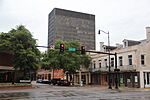 |
220 | 67 | 17 | 1967 |
People of Augusta
| Historical population | |||
|---|---|---|---|
| Census | Pop. | %± | |
| 1800 | 2,215 | — | |
| 1810 | 2,476 | 11.8% | |
| 1830 | 6,710 | — | |
| 1840 | 6,403 | −4.6% | |
| 1850 | 9,448 | 47.6% | |
| 1860 | 12,493 | 32.2% | |
| 1870 | 15,389 | 23.2% | |
| 1880 | 21,891 | 42.3% | |
| 1890 | 33,300 | 52.1% | |
| 1900 | 39,441 | 18.4% | |
| 1910 | 41,040 | 4.1% | |
| 1920 | 52,548 | 28.0% | |
| 1930 | 60,342 | 14.8% | |
| 1940 | 65,919 | 9.2% | |
| 1950 | 71,508 | 8.5% | |
| 1960 | 70,626 | −1.2% | |
| 1970 | 59,864 | −15.2% | |
| 1980 | 47,532 | −20.6% | |
| 1990 | 44,639 | −6.1% | |
| 2000 | 195,182 | 337.2% | |
| 2010 | 195,844 | 0.3% | |
| 2020 | 202,081 | 3.2% | |
| U.S. Decennial Census 1850-1870 1870-1880 1890-1910 1920-1930 1940 1950 1960 1970 1980 1990 2000 2010 2020 |
|||
| Race / Ethnicity (NH = Non-Hispanic) | Pop 2000 | Pop 2010 | Pop 2020 | % 2000 | % 2010 | % 2020 |
|---|---|---|---|---|---|---|
| White alone (NH) | 85,340 | 73,277 | 65,721 | 43.72% | 37.42% | 32.52% |
| Black or African American alone (NH) | 97,517 | 105,921 | 111,535 | 49.96% | 54.08% | 55.19% |
| Native American or Alaska Native alone (NH) | 491 | 557 | 480 | 0.25% | 0.28% | 0.24% |
| Asian alone (NH) | 2,925 | 3,259 | 3,898 | 1.50% | 1.66% | 1.93% |
| Pacific Islander alone (NH) | 222 | 370 | 386 | 0.11% | 0.19% | 0.19% |
| Other race alone (NH) | 359 | 305 | 880 | 0.18% | 0.16% | 0.44% |
| Mixed race or Multiracial (NH) | 2,881 | 4,102 | 7,910 | 1.48% | 2.09% | 3.91% |
| Hispanic or Latino (any race) | 5,447 | 8,053 | 11,271 | 2.79% | 4.11% | 5.58% |
| Total | 195,182 | 195,844 | 202,081 | 100.00% | 100.00% | 100.00% |
In 2020, Augusta had 202,081 people living in the city. There were 66,838 households and 41,517 families. The city's population has grown over the years.
The people living in Augusta come from many different backgrounds. In 2020, about 55% of the population was African American, and about 35% was non-Hispanic white. There are also growing Asian, Native American, and multiracial communities. About 5.5% of the population is Hispanic or Latino.
Education in Augusta
Colleges and Universities
Augusta has several colleges and universities:
- Augusta Technical College (a state technical college)
- Augusta University (a public research university)
- Paine College (a private college with a history of serving Black students)
Some colleges also have smaller campuses in Augusta:
- East Georgia State College
- Georgia Military College
- Brenau University
Schools for Kids (K-12)
Public schools in Augusta are run by the Richmond County School System. This system includes 36 elementary schools, 10 middle schools, and 8 high schools. Some of the high schools are Glenn Hills, Butler, and A.R.C..
There are also four special "magnet" schools. These schools focus on certain subjects like health science, engineering, or fine arts. Examples are C. T. Walker Traditional Magnet School and Davidson Fine Arts.
Augusta also has many private schools, such as Aquinas High School and Westminster Schools of Augusta.
Media and News
The main newspaper in Augusta is The Augusta Chronicle.
You can watch several TV stations in Augusta:
- WAGT (NBC and CW Plus)
- WCES (PBS)
- WFXG (Fox)
- WJBF (ABC and MeTV)
- WRDW (CBS)
There's also a newspaper called the Medical Examiner that focuses on the city's large medical community.
Augusta's Economy
Augusta is a big center for medicine, science (biotechnology), and computer security (cyber security). Augusta University is a major employer, with over 7,000 people working there. The city's medical area employs over 25,000 people.
The three biggest employers in Augusta are:
- Augusta University
- The Savannah River Site (a nuclear facility)
- Fort Eisenhower, which is home to the U.S. Army Cyber Center of Excellence. This center trains soldiers in cyber, signal, and electronic warfare.
Augusta has become a hub for cyber security companies. This is partly because the United States Army Cyber Command moved to Fort Eisenhower. Augusta also hosts the TechNet conference each year. This event brings together military, government, and private leaders to discuss new cyber products and teamwork.
Many companies have offices or factories in Augusta. Some well-known names include T-Mobile, Clearwater Paper, Bridgestone, E-Z-GO, John Deere, and Kellogg's.
Who are the Top Employers?
Here are some of the top manufacturing companies that employ people in Augusta:
| # | Employer | # of employees |
|---|---|---|
| 1 | Textron Specialized Vehicles | 1,350 |
| 2 | Graphic Packaging International | 963 |
| 3 | Ferrara USA | 900 |
| 4 | FPL Food | 660 |
| 5 | Thermal Ceramics | 400 |
| 6 | Cardinal Health | 390 |
| 7 | Nutrien | 390 |
| 8 | Augusta Coca-Cola | 300 |
| 9 | Solvay Advanced Partners | 300 |
| 10 | Starbucks | 260 |
And here are the top public (government-related) employers:
| # | Employer | # of employees |
|---|---|---|
| 1 | Fort Eisenhower | 29,252 |
| 2 | Augusta University | 6,775 |
| 3 | NSA Georgia | 6,000 |
| 4 | Augusta University Health System | 5,341 |
| 5 | Richmond County School System | 4,418 |
| 6 | Piedmont Augusta | 3,000 |
| 7 | Augusta–Richmond County | 2,840 |
| 8 | Charlie Norwood VA Medical Center | 2,082 |
| 9 | Doctors Hospital | 1,837 |
| 10 | East Central Regional Hospital | 1,400 |
Sports in Augusta
Local Sports Teams
- The Augusta GreenJackets are a minor league baseball team. They play at SRP Park in North Augusta, South Carolina. They are linked with the Atlanta Braves.
- The Augusta Lynx were a professional ice hockey team that played from 1998 to 2008.
- The Augusta RiverHawks were another professional ice hockey team that played from 2010 to 2013.
- The Augusta Stallions were an Arena football team that played from 1999 to 2002.
- The Augusta Rugby Football Club (ARFC) is a men's rugby team.
- The Soul City Sirens are an all-female roller derby team.
- The Augusta 706ers were a professional basketball team that played briefly.
| Club | Sport | League | Venue |
|---|---|---|---|
| Augusta GreenJackets | Baseball | Low-A East | SRP Park |
| Augusta Mad Dogs | Rugby | Palmetto Rugby Union | Larry Bray Memorial Pitch |
| Augusta Furies | Women's Rugby | Carolinas Geographic Union | Larry Bray Memorial Pitch |
| Soul City Sirens | Roller derby | WFTDA | Red Wing Rollerway |
| Georgia Soul | Basketball | Women's American Basketball Association | Butler High School Gymnasium |
| Georgia Soul | Basketball | The Basketball League | H.E.A.L. Complex at Paine College |
Sports Tournaments

Augusta is famous for the Masters golf tournament. It's held every April at the Augusta National Golf Club. This is one of the biggest golf events in the world. The golf course is known for being very beautiful.
The city also has places for disc golf. Augusta hosted the 2006 Professional Disc Golf World Championships. Many disc golfers from around the world came to compete.
Augusta used to host the Augusta Southern Nationals, a drag boat race on the Savannah River. It was known as the "World's Richest Drag Boat Race."
Augusta is also home to one of the biggest Ironman 70.3 competitions in North America. Athletes swim in the Savannah River, bike around Augusta, and run through downtown. The city has also hosted the USA Cycling Collegiate Road National Championships.
Parks and Fun Things to Do
Augusta has many great parks and places for recreation:
- Riverwalk Augusta – A park along the city's river levee. It's a great place to walk.
- Augusta Common – A green space with a statue of James Oglethorpe.
- Augusta Canal – A historic canal with paths for biking and walking.
- Phinizy Swamp Nature Park – A wetlands park with paths and boardwalks.
- Diamond Lakes Regional Park – A large park in the southern part of Richmond County.
- Brookfield Park – A public park with a playground, putting green, and paths.
- Pendleton King – A public park with a disc golf course, dog park, and gardens.
Getting Around Augusta
Augusta is connected to other cities by major highways. I-20 goes west to Atlanta and east to Columbia, South Carolina. I-520 (also called Bobby Jones Expressway) goes around Augusta's western and southern areas.
Other important roads include U.S. Route 1, U.S. Route 25, and U.S. Route 78. These roads connect Augusta to nearby towns and cities.
Major Roads and Highways
 I-20 (Carl Sanders Highway)
I-20 (Carl Sanders Highway) I-520 (Bobby Jones Expressway / Deputy James D. Paugh Memorial Highway)
I-520 (Bobby Jones Expressway / Deputy James D. Paugh Memorial Highway) US 1 (Deans Bridge Road; Gordon Highway; Fall Line Freeway)
US 1 (Deans Bridge Road; Gordon Highway; Fall Line Freeway) US 25 (Peach Orchard Road; Gordon Highway)
US 25 (Peach Orchard Road; Gordon Highway) US 25 Bus. (Broad Street / 13th Street)
US 25 Bus. (Broad Street / 13th Street)
 US 78 / US 278 (Gordon Highway)
US 78 / US 278 (Gordon Highway) SR 4
SR 4 SR 28 (John C. Calhoun Expressway and Washington Road)
SR 28 (John C. Calhoun Expressway and Washington Road) SR 56 (Mike Padgett Highway)
SR 56 (Mike Padgett Highway) SR 88
SR 88 SR 104 (Washington Road; Pleasant Home Road; River Watch Parkway)
SR 104 (Washington Road; Pleasant Home Road; River Watch Parkway) SR 104 Conn. (Washington Road)
SR 104 Conn. (Washington Road) SR 232 (Columbia Road / Bobby Jones Expressway)
SR 232 (Columbia Road / Bobby Jones Expressway) SR 383 (Jimmie Dyess Parkway)
SR 383 (Jimmie Dyess Parkway) SR 540 (Fall Line Freeway)
SR 540 (Fall Line Freeway)
 SR 555 / SR 565 (Savannah River Parkway)
SR 555 / SR 565 (Savannah River Parkway)
Most people in Augusta get around by car. There is also a city bus service called Augusta Public Transit (APT).
Airports in Augusta
Augusta has two airports:
- Augusta Regional Airport: This airport has flights to cities like Atlanta, Charlotte, and Dallas-Ft. Worth.
- Daniel Field: A smaller airport.
Train Services
In the past, Augusta had a busy train station for passengers. Today, trains mostly carry freight (goods). Companies like Norfolk Southern Railway and CSX Transportation operate freight trains through Augusta. You can sometimes see these trains moving slowly through downtown Augusta.
Walking and Biking Paths
Augusta has several trails for walking and biking:
- Augusta Canal Historic Trail
- New Bartram Trail
- Phinizy Swamp Constructed Wetlands Trail
- River Levee Trail
- Riverwalk Augusta Trail
Famous People from Augusta
Sister Cities
Augusta has "sister city" relationships with two cities in other countries:
 Biarritz, France
Biarritz, France Takarazuka, Japan
Takarazuka, Japan
See also
 In Spanish: Augusta (Georgia) para niños
In Spanish: Augusta (Georgia) para niños


